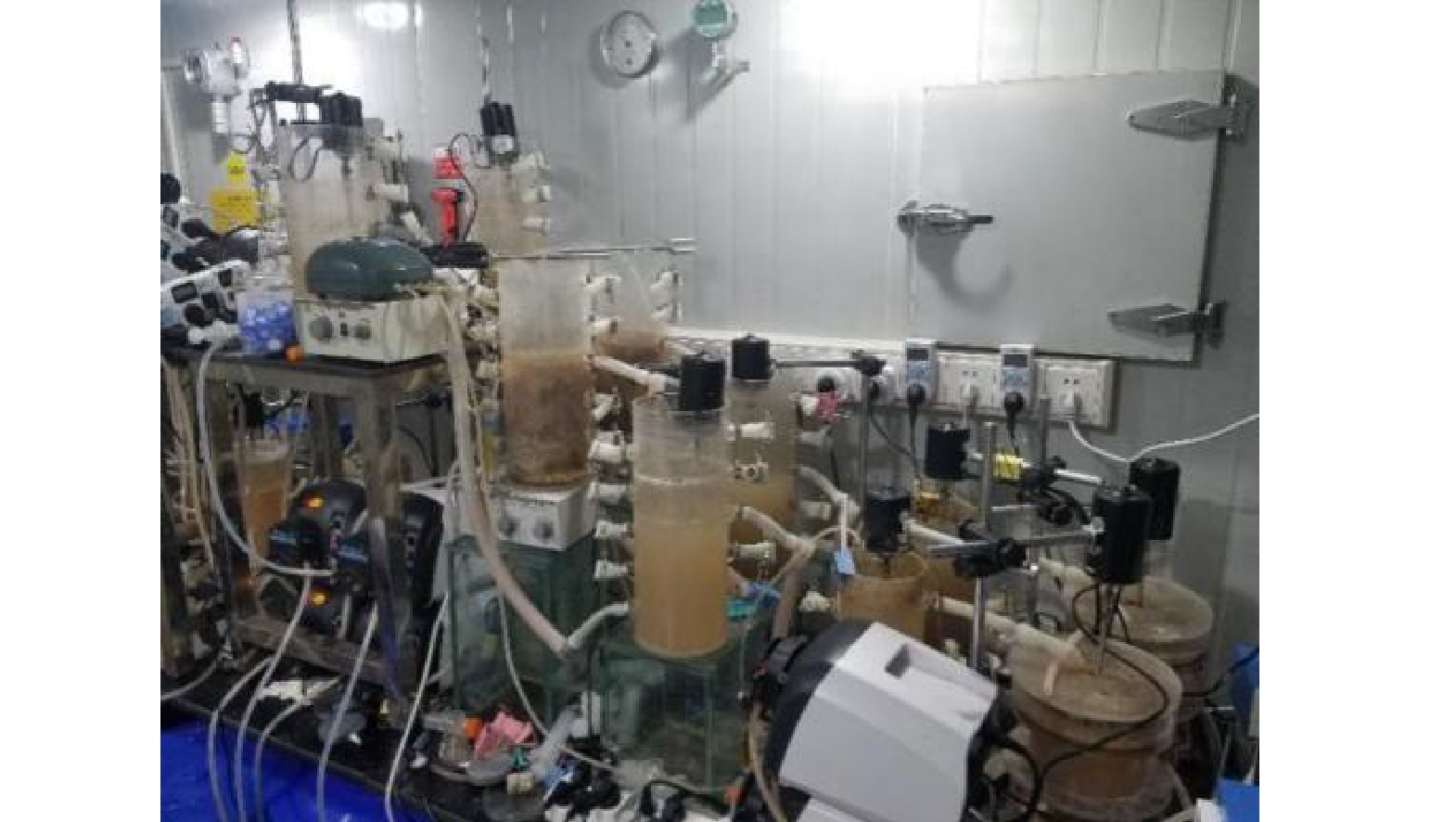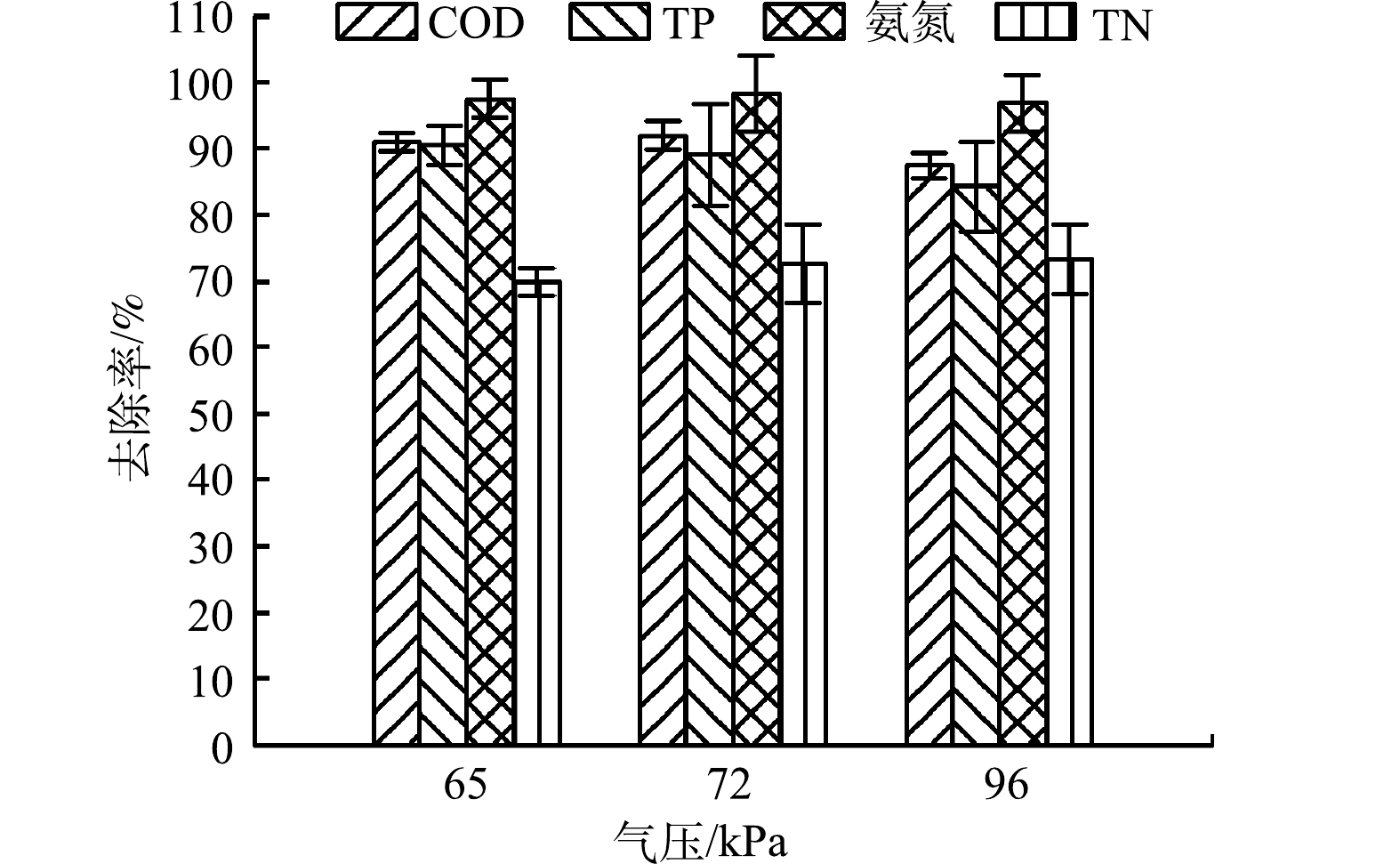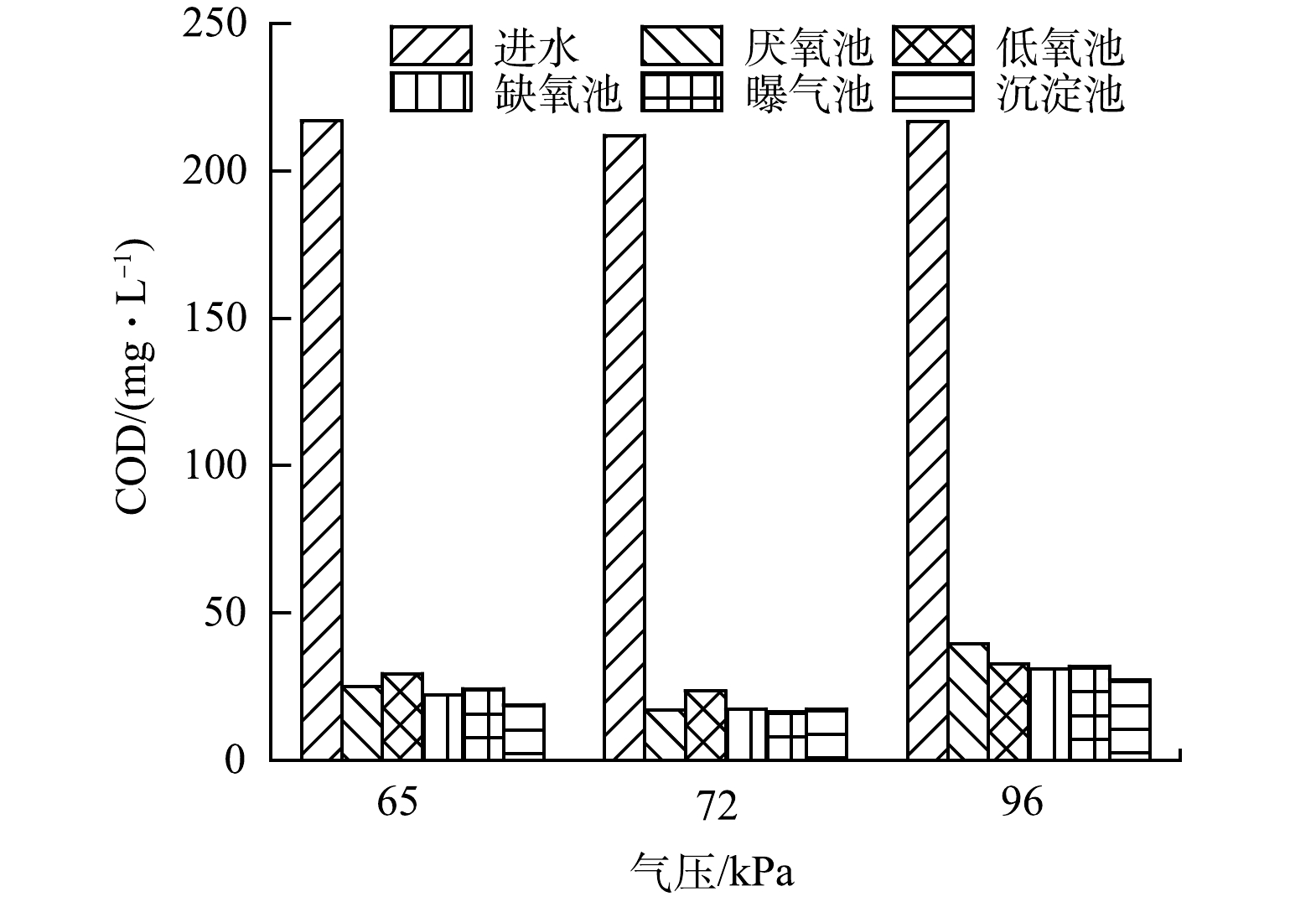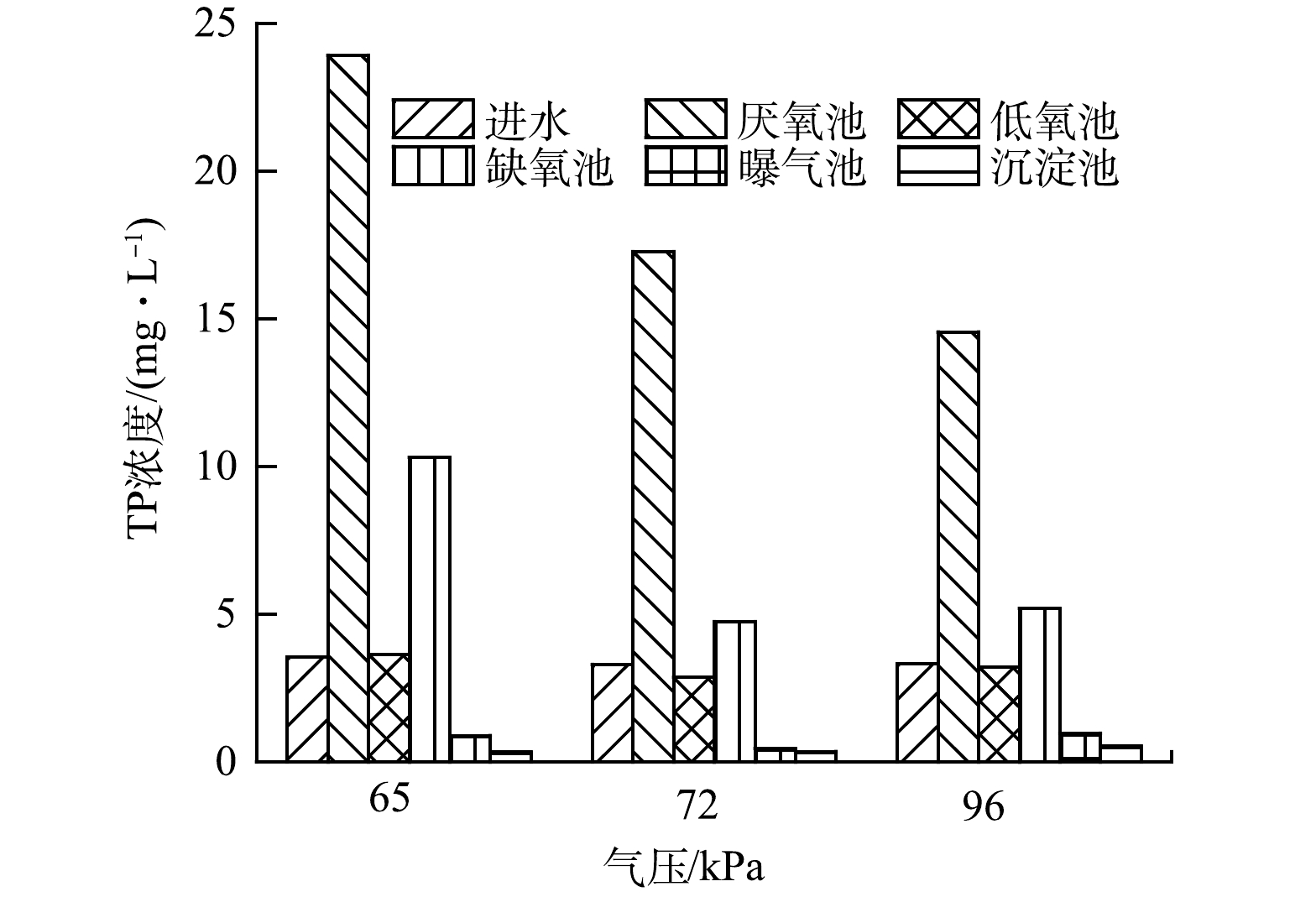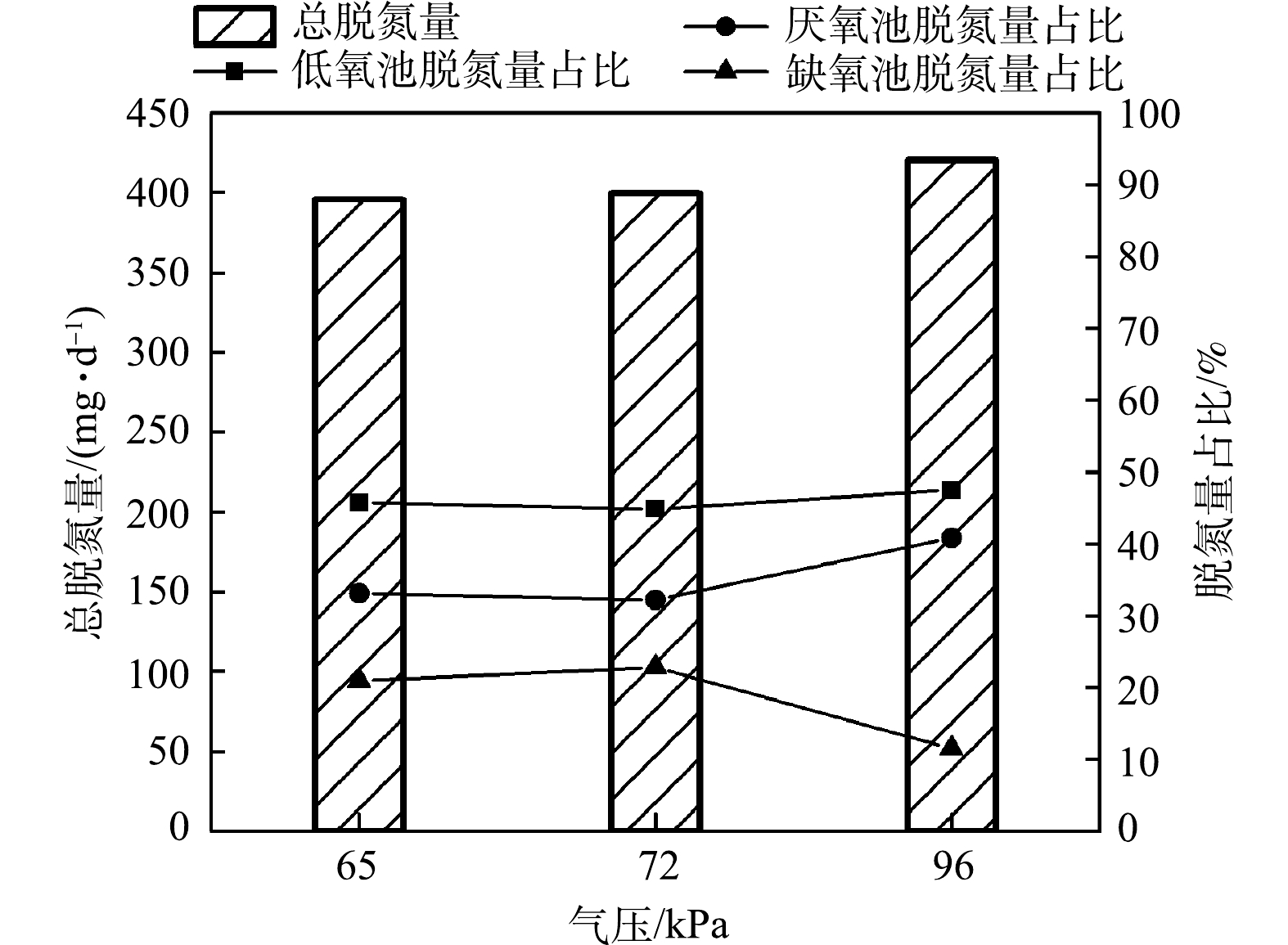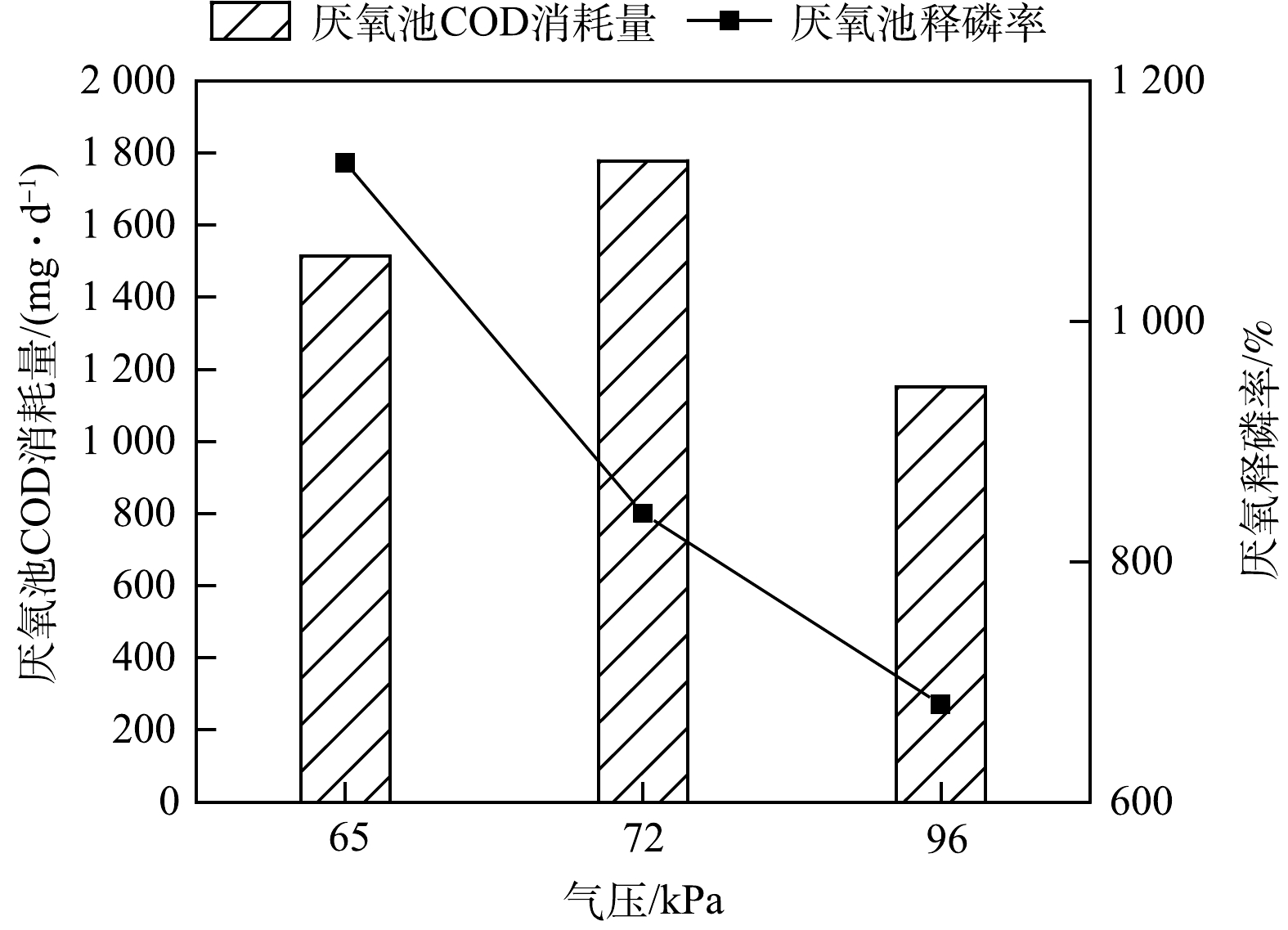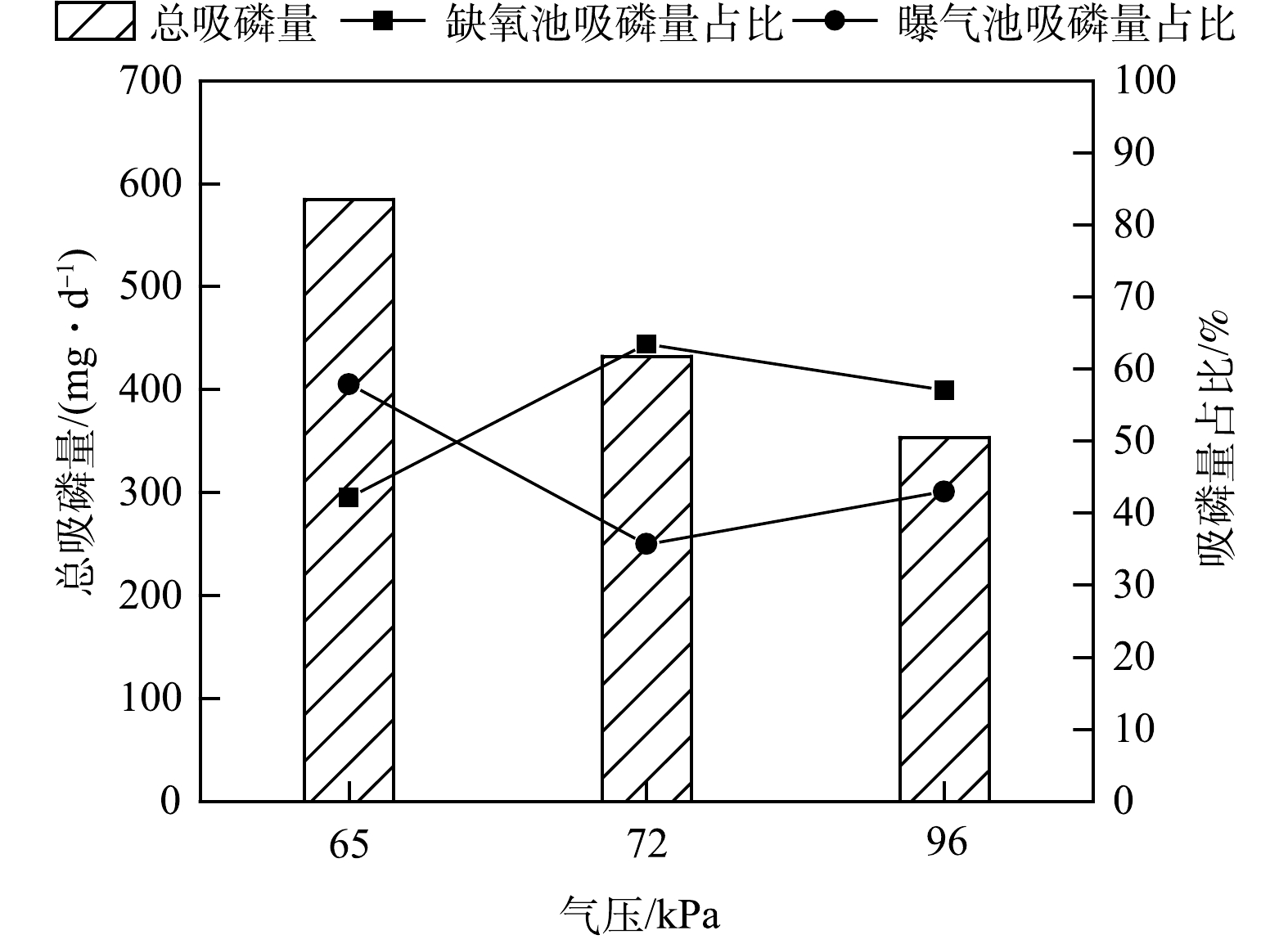-
目前城镇生活污水基本采用活性污泥法除磷脱氮工艺,通过功能菌群实现氮磷的去除。青藏高原海拔3 000~5 000 m,年均气压、含氧量、大气密度分别相当于海平面的50%、60%和66%,其紫外线辐射强度是内陆其他地区的1.5~2.5倍[1-2]。高原地区的平均温度低、氧含量低和气压低的“三低”特殊环境,对活性污泥系统的运行、微生物的代谢以及污染物的去除途径造成不同程度的影响[3],随着海拔的升高,高原污水处理厂中的脱氮微生物显著减少[4]。高海拔地区大部分生活污水处理厂的设计及建设照搬内地经验,未充分考虑高海拔条件对污水处理系统运行的影响[5]。已有较多关于低氧和低温条件对活性污泥系统影响的研究,发现相同曝气量下高原地区的有效供氧量仅为平原地区的50%左右[6],低溶解氧会抑制硝化作用,促进短程硝化和同步硝化反硝化的进行[7],且低氧条件影响好氧吸磷的速率[8]。低温是影响活性污泥系统的重要因素之一,可使微生物的比增长速率降低,活性污泥生物量也随之减少[9],微生物的代谢活性降低[10],造成硝化和反硝化作用减弱,导致整体脱氮效能下降[11]。
在温度不变时,气体在水中的溶解度随着气压的降低而减小,气压的变化不仅会直接影响氧气的溶解度,还将间接影响氧气的传质[12]。本团队前期研究结果表明,氧气的传质受到曝气量、大气压力以及污泥浓度的影响,其影响程度为曝气量>大气压力>污泥浓度[13]。此外,污水生物处理不仅包含好氧微生物的氧气利用,也包括异养微生物降解有机物生成二氧化碳、反硝化微生物还原硝酸盐生成氮气等过程。低压导致二氧化碳以及氮气分压的降低,造成二氧化碳和氮气的溶解度下降,而气液传质的限制将形成潜在的气体产物过饱和问题,抑制反应的正向进行[14]。二氧化碳溶解度的降低也将引起反应池的pH上升,影响微生物的正常代谢[15]。前期研究[16]表明,即使控制相同的溶解氧条件,不同气压培养下的活性污泥群落结构及功能微生物活性也存在差异。上述研究结果表明,气压不仅影响活性污泥的微生物结构和代谢活性,而且影响污水处理过程中的溶解氧含量和气体的传质,进而影响污染物的去除效率和途径。为实现高海拔地区生活污水氮磷的有效去除,本研究针对低压低氧环境,提出了一套改良型双污泥除磷脱氮工艺[17],该工艺可有效富集功能菌群,工艺简洁,运维简单,在低压条件下具有良好稳定的处理效率,但气压对该系统碳氮磷去除效率和去除途径的影响尚不明晰。为此,本文以改良型双污泥除磷脱氮工艺在不同气压条件下稳态运行期间的数据为基础,探讨了比较不同气压下的工艺运行效能和污染物的去除途径,结合物料衡算方法,分析3气压对改良型双污泥除磷脱氮工艺系统的影响机制,为改良型双污泥工艺在高海拔地区市政污水处理中的应用提供参考。
-
图1和图2分别为改良型双污泥除磷脱氮工艺实验装置示意图和实物图[15],装置包括进水箱、进水泵、厌氧池、低氧池、缺氧池、曝气池、沉淀池、空气泵和污泥回流泵,原水按一定比例同时进入低氧池和厌氧池。低氧池采用生物膜法,以实现大部分有机物的去除,部分氨氮通过硝化作用转化为NO3−,部分通过同步硝化反硝化作用进行脱氮;在厌氧池中,聚磷菌(PAOs)吸收大量的有机底物并释磷。缺氧池中,反硝化聚磷菌(DPAOs)以低氧池提供的NO3−作为电子受体,进行反硝化除磷。曝气池主要用于吸收剩余的磷、去除剩余氨氮和有机物,保证出水达标;沉淀池污泥按照一定比例回流至厌氧池。
主体反应器采用有机玻璃材质,厌氧池、低氧池、缺氧池和曝气池的有效容积分别为2、3、3和4 L。低氧池组合填料材质为全塑性夹片维纶醛化丝,直径为120 mm,比表面积350~400 m2·m−3,填充率为70%~80%。
-
本实验基于西藏地区城镇生活污水水质调研分析结果,采用人工模拟西藏地区实际污水作为进水,模拟污水采用超纯水配置,成分如下:256.41 mg·L−1 CH3COONa、76.42 mg·L−1 NH4Cl、13.17 mg·L−1 KH2PO4、25.00 mg·L−1 NaCl、15.00 mg·L−1 MgSO4·7H2O、750.00 mg·L−1 CaCl2、50.00 mg·L−1 NaHCO3、0.50 mL 微量元素溶液,其中微量元素的成分与浓度如下:1.50 g·L−1 FeCl3·6H2O、0.10 g·L−1 MnSO4·H2O、0.15 g·L−1 H3BO3、0.06 g·L−1 Na2MoO4·2H2O、0.03 g·L−1 CuSO4·5H2O、0.12 g·L−1 ZnSO4·7H2O、0.03 g·L−1 KI、0.15 g·L−1 CoCl2·6H2O、10.00 g·L−1 EDTA。实验中进水化学需氧量(COD)、氨氮和总磷(TP)分别为180.00~220.00、20.00~25.00 和2.80~3.50 mg·L−1。
-
实验在陕西省咸阳市西藏民族大学进行,考察了高海拔地区不同气压下改良型双污泥工艺的脱氮除磷效果。基于陕西省咸阳市、西藏自治区林芝市和拉萨市当地大气压,设定气压为96、72和65 kPa,低压环境由高海拔环境模拟实验舱提供[16]。系统进水流量为24 L·d−1,其中进入低氧池和厌氧池的水量之比为1:1;厌氧池、低氧池、缺氧池、曝气池的水力停留时间(HRT)分别为3.0、3.0、4.0、2.0 h;污泥回流比50%左右,控制污泥龄(SRT)为20 d (不考虑低氧池) ;低氧池溶解氧(DO)控制为2.0~2.5 mg·L−1,曝气池DO为3.0~4.0 mg·L−1。不同气压工况均运行30 d左右,各反应池(低氧池除外)的污泥(MLSS)质量浓度维持在1 000 mg·L−1左右。
-
每天所采集水样经0.45 μm滤膜过滤后测定,COD、TP、氨氮、NO3−-N、NO2−-N和MLSS根据国标法测定[18],DO和pH由测定仪(HQ30d和HQ1110d,美国)测定。
-
工艺系统中碳的物料衡算使用COD的质量变化进行描述。稳定状态下,进入系统的COD总量等于系统出水、各反应池内的消耗及剩余污泥中的COD之和,碳平衡根据式(1)~式(7)计算。
式中:Minf.COD为系统进水的COD总量,mg·d−1;Meff.COD为系统出水的COD总量,mg·d−1;MAN.COD为厌氧池消耗的COD总量,mg·d−1;MH.COD为低氧池消耗量,mg·d−1;M(A-S) .COD为缺氧池和曝气池沉淀池消耗的COD总量,mg·d−1;MW.COD为剩余污泥中的COD总量,mg·d−1;Qin为进水流量 (L·d−1) ;Cin.COD为系统进水COD,mg·L−1;t为低氧池流量与总进水流量之比;QR为回流污泥流量,L·d−1;CR.COD为回流污泥的COD,mg·L−1;CAN-A.COD为厌氧池出水COD,mg·L−1;CH-A.COD为低氧池出水COD,mg·L−1;Ceff.COD为系统出水COD,mg·L−1;Qeff为出水流量,L·d−1;QW为剩余污泥排放量,L·d−1;XW为剩余污泥浓度,mg·L−1;f为挥发性活性污泥浓度与剩余活性污泥浓度的比值,根据实验结果,本文取0.65;fCV为活性污泥中有机物COD的化学计量系数,从理论上来说,不同生物处理系统的fCV会有差异,但大量研究表明每mg挥发性活性污泥中含有1.48 mg COD时,能较好地代表系统中的微生物特性同时能反应实际情况,此处取1.48[19]。
-
进入到系统中的氮形态主要分为氨氮和硝态氮,反应后一部分流出反应器,一部分经反硝化作用去除,一部分经同化作用被去除,其余部分随剩余污泥排放。稳定状态下,氮平衡计算如式(8)~式(16)。
式中:Minf.N为系统进水的氮质量,mg·d−1;Meff.N为系统出水的氮质量,mg·d−1;MDE.N为经反硝化作用去除的氮质量,mg·d−1;Mloss.N为经同化作用被去除的氮质量,mg·d−1;MW.N为随剩余污泥排放的氮质量,mg·d−1;MAN.N为厌氧池反硝化去除的氮质量,mg·d−1;MH.N为低氧池同步硝化反硝化去除的氮质量,mg·d−1;MA .N为缺氧池反硝化去除的氮质量,mg·d−1;Cin.N为系统进水氮的浓度,mg·L−1;Ceff.N为系统出水氮的浓度,mg·L−1;CR.N为回流污泥中氮的浓度,mg·L−1;CAN-A.N为厌氧池流入缺氧池的氮浓度,mg·L−1;CH-A.N为低氧池流入缺氧池的氮浓度,mg·L−1;CA-O.N和CO-S.N分别为缺氧池流入曝气池和曝气池流入沉淀池的氮浓度,mg·L−1;fN为活性污泥中氮的质量分数,根据南非水研究协会的建议,在一定的污泥龄范围内fN取0.10 mg/mg是较合理的且能反应实际情况的,此处取0.10[20]。
-
磷的去除主要通过剩余污泥的排放实现,因此,系统磷的物料衡算时可只考虑进水中的磷、出水中的磷和剩余污泥中的磷三部分。稳定状态下,进入系统中的磷等于系统出水中的磷与剩余污泥中的磷之和,平衡计算如式(17)~式(23)。
式中:Minf.P为系统进水的磷质量,mg·d−1;Meff.P为系统出水的磷质量,mg·d−1;MW.P为剩余污泥中的磷质量,mg·d−1;Cin.P为系统进水磷浓度,mg·L−1;Ceff.P为系统出水磷浓度,mg·L−1;MA.P为缺氧池去除的磷质量,mg·d−1;MO.P为曝气池去除的磷质量,mg·d−1;MAN.P为厌氧池释放的磷质量,mg·d−1;CH-A.P为从低氧池流入缺氧池的磷浓度,mg·L−1;CAN-A.P为从厌氧池流入缺氧池的磷浓度,mg·L−1;CA-O.P为从缺氧池流入曝气池的磷浓度,mg·L−1;CO-S.P为从曝气池流入沉淀池的磷浓度,mg·L−1;CR.P为回流污泥的磷浓度,mg·L−1。
-
本研究选取了在65、72和96 kPa条件下稳定运行期间的进出水水质数据(表1)进行改良型双污泥系统运行性能的分析(图3)。由表1可以看出,该系统具有良好的脱氮除磷效果,96 kPa时,出水COD 值接近30 mg·L−1,在72 kPa和65 kPa下,出水COD 值低于20 mg·L−1;在3种气压条件下,出水氨氮质量浓度均低于1 mg·L−1,出水总氮质量浓度低于10 mg·L−1;当气压为72 kPa和65 kPa时,出水总磷质量浓度低于0.5 mg·L−1。上述结果表明,72 kPa和65 kPa下,改良型双污泥系统稳定运行期间出水水质达到《城镇污水处理厂污染物排放标准》(GB 18918-2002)一级A标准。
由图3可知,气压从96 kPa降低至65 kPa时,总磷去除率由84.23%提升至90.44%,脱氮率由73.37%降低至69.89%,COD的去除率由87.45%提高至90.94%。气压的降低可提升改良型双污泥除磷脱氮工艺的COD和总磷的去除性能。
-
3个大气压力下改良型双污泥系统稳定运行期间的各反应器内碳氮磷的沿程变化 (平均值) 图4~图6所示。由图5和图6可知,该系统在3个气压下均具有良好的脱氮除磷效果,但气压对系统各反应器的功能产生了显著影响。
1)系统各工艺单元COD的消耗。由图4可见,不同气压下各单元中的COD值存在一定的差异。当气压从96 kPa下降至65 kPa时,厌氧池中的COD值从39.41 mg·L−1降至25.00 mg·L−1,低氧池COD值从32.64 mg·L−1降低至29.41 mg·L−1,曝气池的COD值从31.76 mg·L−1降低至24.26 mg·L−1,沉淀池的COD值从27.20 mg·L−1降低至18.91 mg·L−1。上述表明,气压的降低使得各反应器单元COD值显著下降,低气压可以提升改良型双污泥系统的COD去除效能。
2)系统各单元脱氮性能。沿程数据表明(图5)系统脱氮通过低氧池的同步硝化反硝化作用、厌氧池和缺氧池的反硝化作用。在溶解氧浓度保持不变的情况下,当气压从96 kPa下降从65 kPa时,低氧池氨氮浓度从4.73 mg·L−1上升至8.77 mg·L−1,硝态氮浓度则从1.91 mg·L−1下降至0.60 mg·L−1。此外,65 kPa下曝气池溶解氧浓度为3.0~4.0 mg·L−1,但仍有1.49 mg·L−1的氨氮未被氧化成硝态氮,表明低气压影响了硝化作用,进而影响了系统的脱氮性能。
3)系统各单元除磷性能。比较3个气压下的总磷浓度的沿程变化(图6),3个气压条件下进水总磷浓度几乎相等,进入厌氧池后,当气压为96 kPa时,厌氧池的总磷浓度为14.57 mg·L−1,在72 kPa和65 kPa下,厌氧池总磷质量浓度分别为17.27 mg·L−1和23.91 mg·L−1,随着气压的降低,厌氧释磷量增大,总磷浓度显著提升。缺氧池和曝气池中的总磷浓度迅速下降,表明总磷在缺氧池和曝气池得到去除。上述结果表明,气压的降低可促进厌氧池释磷过程,使系统除磷效果有所提升。72 kPa时低氧池的硝态氮质量浓度为2.55 mg·L−1,相对于65 kPa和92 kPa时,进入缺氧池的硝氮浓度高,硝氮和总磷同时得到有效去除,表明反硝化除磷是缺氧池内磷去除的主要途径。
-
为进一步分析系统COD、氮和磷的去除途径,明晰系统各功能单元对碳氮磷去除的贡献率,本文利用系统稳定运行期间的平均沿程数据进行物料衡算分析。
1) COD去除途径和质量分布。不同气压下系统COD的物料平衡计算结果如表2所示。在96、72和65 kPa下,厌氧池对COD去除的贡献率分别为36.32%、45.67%和41.76%;低氧池对COD去除的贡献率分别为46.78%、49.10%和47.50%。由此可知厌氧池和低氧池为改良型双污泥除磷脱氮工艺COD的主要去除途径,且低氧池的COD消耗量大于厌氧池。
相对于96 kPa和72 kPa下,65 kPa时低氧池对COD消耗量最小,与96 kPa相比,COD的消耗量减少了60.71 mg·d−1。这是因为低氧池的氨氮浓度提高,反硝化脱氮量降低,COD的消耗量也随之减少。然而对于厌氧池来说,与96 kPa相比,65 kPa时COD的消耗量了增加了245.68 mg·d−1,其原因为水中氧分压随气压的下降而降低,有利于厌氧池厌氧环境的形成,一方面促进了厌氧池的释磷量增大,提高了碳源的消耗量;另一方面,随着气压的降低,低氧池、厌氧池和缺氧池的氨氮积累量增加,经曝气池后,回流污泥中携带有较多的硝态氮回到厌氧池,反硝化脱氮消耗的COD量增加。
2)氮去除途径和质量分布。不同气压下系统中氮的物料平衡计算结果如表3所示。进入系统的氮,主要由低氧池生物膜的同步硝化反硝化作用、厌氧池和缺氧池的反硝化作用去除,少部分被微生物同化作用所去除,剩余部分分别随出水和剩余污泥排出系统。表3中部分Mloss.N值为负数,说明出水氮有了些许增加,推测是因为少量细胞老化解体。在96 kPa下,反硝化脱氮量占进水TN的68.08%,低氧池、厌氧池和缺氧池分别占30.58%、21.95%和15.55%,低氧池、厌氧池和缺氧池对氮去除的贡献率分别为48.42%、41.64%和11.79%,说明厌氧池和低氧池为改良型双污泥除磷脱氮工艺氮的主要去除途径。65 kPa时,反硝化去除的氮占进水TN的66.38%,低氧池、厌氧池和缺氧池分别占30.42%、22.02%和13.94%,低氧池、厌氧池和缺氧池对氮去除的贡献率分别为43.62%、31.57%和19.98%,缺氧池成为脱氮的重要单元。
65 kPa下,曝气池的氮损失量为26.264 mg·d−1,占进水TN的比例为4.41%,本团队的研究表明随气压降低,氧传质速率降低,导致活性污泥分泌的胞外聚合物和溶解性微生物产物均增多,其中蛋白质含量显著上升[13],这部分氮损失可能是因为微生物同化作用所去除。
3)磷去除途径和质量分布。不同气压下工艺系统磷的物料平衡如表4所示。进入系统的磷,经厌氧池释磷、缺氧池聚磷和好氧池吸磷后,大部分富集在剩余污泥中被排出系统,少部分随出水流出系统。由表4可知,系统的磷去除途径主要包括曝气池的好氧吸磷作用和缺氧池的反硝化聚磷作用。当气压96 kPa降低至65 kPa时,好氧吸磷量占总磷去除量的比例由42.99%提高至57.86%,而缺氧池的反硝化聚磷量占总磷去除量的比例则由57.01%降至42.14%。因此,随着气压的降低,好氧吸磷成为该系统除磷的主要途径。其主要原因为:一是随着气压的降低,厌氧池的厌氧环境更加良好,促进厌氧池释磷过程,释磷量从96 kPa的298.09 mg·d−1提高至65 kPa时的520.31 mg·d−1,释磷量提高了1.74倍,有利于好氧吸磷;二是随着气压的下降,低氧池的硝态氮浓度降低,使得低氧池提供给缺氧池的电子受体数量不足,影响了缺氧池的反硝化聚磷,当气压为65 kPa时,缺氧池的每天反硝化除磷量(246.43 mg·d−1)小于好氧吸磷量(338.40 mg·d−1),使反硝化除磷成为系统除磷的次要途径。
4)系统脱氮除磷途径分析。通过对系统的碳、氮、磷 进行物料平衡分析,厌氧池和低氧池为改良型双污泥除磷脱氮工艺系统COD的主要去除途径,且低氧池的COD去除贡献率大于厌氧池,厌氧池对COD去除的贡献率随气压的降低而提高。厌氧池的反硝化作用和低氧池的同步硝化反硝化作用为该系统氮的主要去除途径,随着气压的降低,厌氧池和低氧池脱氮量均下降,缺氧池的脱氮量提高,使之成为系统脱氮的重要单元,低气压使得曝气池微生物的同化作用成为该系统脱氮的途径之一。系统磷的去除途径主要是曝气池的好氧吸磷作用和缺氧池的反硝化聚磷作用,随着气压的降低,厌氧释磷量增加,好氧吸磷成为该系统除磷的主要途径,低气压下缺氧池获得的电子受体数量不足,影响了缺氧池的反硝化聚磷,反硝化聚磷作用转变为该系统除磷的次要途径。
-
上述结果表明,气压对改良型双污泥系统的除磷脱氮性能产生了显著影响,为此,进一步考察了气压对本系统除磷脱氮机制的影响。
1)气压对脱氮性能及途径的影响机制。图7给出了不同气压下反硝化脱氮量。由图7中可以看出,随气压的降低,整个系统的反硝化脱氮量从96 kPa时的420.66 mg·d−1下降至65 kPa时的395.66 mg·d−1,两者呈现明显的正相关关系。这是因为:随气压降低,氧传质速率下降[13],氨氧化菌的丰度和活性随之减小[16],低氧池硝化功能受限,进而限制了同步硝化反硝化作用;随气压降低,系统除磷效率升高,除磷菌的COD利用量增加,用于反硝化菌的有机物量降低,导致脱氮量减少[16]。
2)气压对除磷性能及途径的影响机制。由图8和图9可以看出,随着气压降低,释磷率和COD的消耗值得到提高,总吸磷量的变化趋势与厌氧池释磷量和释磷率的变化趋势一致。此外,缺氧池聚磷量所占百分比基本成下降趋势,而曝气池聚磷量所占百分比基本成上升趋势。这是因为气压的降低可抑制低氧池硝化功能[4],提供的电子受体数量减少,不利于缺氧池反硝化聚磷的发生,导致缺氧池的聚磷比例呈下降趋势,而曝气池的除磷量增加。
-
1)在低气压 (高海拔) 环境下,改良型双污泥除磷脱氮工艺系统稳定运行期间能够促进厌氧池释磷过程和碳源利用,出水水质达到了《城镇污水处理厂污染物排放标准》(GB 18918-2002)一级A标准。
2)当气压从96 kPa降低至65 kPa时,COD的去除率由87.39%提高至90.89%,总磷去除效率由83.83%提升至90.14%。厌氧释磷过程对碳源的转化和反硝化过程对碳源的利用是系统COD的主要去除途径,好氧吸磷作用和反硝化聚磷作用是磷去除的主要途径。气压的降低促进了厌氧池释磷过程和碳源利用,总磷的去除率增加,厌氧池对COD去除的贡献率随气压的降低而提高。
3)厌氧池的反硝化作用和低氧池的同步硝化反硝化作用是该工艺系统氮的主要去除途径,然而,当气压从96 kPa降低至65 kPa时,低氧池硝化功能受限,限制了同步硝化反硝化作用,系统脱氮量随气压下降而降低,脱氮率由72.92%降低至69.74%,此外,随着气压的降低,曝气池同化脱氮量增加。
气压对改良型双污泥工艺污染物去除途径的影响
Influence of atmospheric pressure on pollutants removal path in the modified dual-sludge process
-
摘要: 基于改良型双污泥除磷脱氮工艺在不同气压条件下稳态运行数据,探讨了海拔分别为400 (96 kPa)、2 800(72 kPa)和3 300 m(65 kPa)下的工艺运行效能。结果表明,当气压从96 kPa降低至65 kPa,COD的去除率从87.45%提高至90.94%,低气压促进了聚磷菌厌氧释磷过程中胞内碳源的合成,有效提高了好氧吸磷效率,系统总磷去除效率从84.23%提升至90.44%。随气压降低,氨氧化菌的丰度和活性降低,低氧池硝化功能受限,进而限制了同步硝化反硝化作用,系统脱氮量减少,脱氮率从73.37%降低至69.89%。工艺各单元水质变化和物料衡算分析结果表明,各气压条件下改良型双污泥工艺磷主要通过好氧吸磷和反硝化聚磷过程去除,氮主要通过厌氧池的反硝化和低氧池的同步硝化反硝化过程去除。此外,随着气压的降低,曝气池中微生物的同化脱氮功能增强。本文结果为改良型双污泥工艺在高海拔地区市政污水处理中的应用提供了一定的理论参考。Abstract: In this study, the operating efficiency of the modified dual-sludge process was discussed based on the data of its steady-state operation at different altitudes of 96 kPa (400 m), 72 kPa (2800 m) and 65 kPa (3300 m). The results showed that when the atmospheric pressure decreased from 96 kPa to 65 kPa, the removal rate of COD increased from 87.45% to 90.94%. The low atmospheric pressure promoted the synthesis of intracellular carbon sources during the anaerobic phosphorus release process of phosphate-accumulating organisms. Therefore, the aerobic phosphorus absorption efficiency increased effectively, and the removal efficiency of total phosphorus in the system increased from 84.23% to 90.44%. The abundance and activity of ammonia oxidizing bacteria decreased with the decrease of atmospheric pressure, and the nitrification function of the hypoxia tank was limited. Then the simultaneous nitrification and denitrification were limited and the denitrification amount of the system decreased, the corresponding denitrification rate decreased from 73.37% to 69.89%. The results of water quality variations along the units in the process and material balance analysis showed that phosphorus was mainly removed by the aerobic phosphorus absorption and denitrifying phosphate-accumulating at 96 kPa, 72 kPa and 65 kPa. Nitrogen was mainly removed by the denitrification process in the anaerobic tank and the simultaneous nitrification and denitrification in the hypoxia tank. In addition, the assimilative denitrification in the aeration tank was enhanced with the decrease of atmospheric pressure. The result in this study provides a certain theoretical basis for the application of the modified dual-sludge process in municipal sewage treatment in high altitude areas.
-

-
表 1 不同气压下各污染物平均进出水浓度
Table 1. Average concentrations of pollutants in influent and effluent at different air pressures mg·L−1
气压/kPa COD/(mg·L−1) TP/(mg·L−1) 氨氮/(mg·L−1) TN/(mg·L−1) 进水 出水 进水 出水 进水 出水 进水 出水 96 215.84±5.67 3.36±0.15 21.90±1.86 23.60±2.02 27.20±4.92 0.54±0.25 0.76±0.98 6.39±1.78 72 213.32±6.38 3.32±0.23 21.50±1.99 23.57±2.37 17.33±5.26 0.38±0.28 0.48±1.27 6.57±2.05 65 207.55±8.45 3.55±0.36 23.13±2.03 24.84±2.01 18.91±3.60 0.35±0.14 0.64±0.71 7.52±1.11 表 2 不同气压下COD的物料平衡
Table 2. Material balance of COD at different air pressures
压强/kPa Minf.COD/(mg·d−1) Meff.COD/(mg·d−1) MAN.COD/(mg·d−1) MH.COD/(mg·d−1) M(A-S) .COD/(mg·d−1) MW.COD/(mg·d−1) 96 5180.23 652.9 1644.32 2198.39 194.09 481 72 5119.71 415.9 2148.22 2277.5 102.94 481 65 4981.2 453.75 1890.6 2137.68 79.38 481 表 3 不同气压下氮的物料平衡
Table 3. Nitrogen material balance at different pressures
压强/kPa Minf.N/(mg·d−1) Meff.N/(mg·d−1) MDE.N Mloss.N./(mg·d−1) MW.N/(mg·d−1) MAN.N/(mg·d−) MH.N/(mg·d−1) MA.N/(mg·d−1) 96 566.376 153.384 171.984 199.968 48.708 −1.764 32.5 72 565.548 157.644 128.876 179.606 91.316 −2.682 32.5 65 596.089 180.373 131.25 181.345 83.068 26.264 32.5 表 4 不同气压下磷的物料平衡
Table 4. Material balance of phosphorus at different pressures
压强/kPa Minf.P/(mg·d−1) Meff.P/(mg·d−1) MW.P MA.P/(mg·d−1) MO.P/(mg·d−1) MAN.P/(mg·d−1) 96 80.04 12.89 201.62 152.06 298.09 72 79.71 9 277.95 154.27 369.11 65 85.28 8.48 246.43 338.4 520.31 -
[1] 宗永臣. 西藏地区自然环境对污水处理效果的影响初探[J]. 市政技术, 2017, 35(3): 132-135. doi: 10.3969/j.issn.1009-7767.2017.03.041 [2] 郝凯越, 陈相宇, 李远威, 等. 林芝市紫外辐射与空气质量的相关性分析[J]. 环境科学与技术, 2018, 041(7): 103-106. doi: 10.19672/j.cnki.1003-6504.2018.07.018 [3] FANG D X, ZHAO G, XU X Y, et al. Microbial community structures and functions of wastewater treatment systems in plateau and cold regions[J]. Bioresource Technology, 2018, 249: 684-693. doi: 10.1016/j.biortech.2017.10.063 [4] NIU L H, LI Y, WANG P, et al. Altitude-scale variation in nitrogen-removal bacterial communities from municipal wastewater treatment plants distributed along a 3600-m altitudinal gradient in China[J]. Science of the Total Environment, 2016, 559: 38-44. doi: 10.1016/j.scitotenv.2016.03.175 [5] 朱康. 高寒地区农村污水处理技术 [D]. 西宁: 青海大学, 2015. [6] 沈鸿滢, 郭玉, 王艳英, 等. 高原地区污水处理厂工程项目案例分析[J]. 净水技术, 2014, 33(2): 9-12,21. doi: 10.3969/j.issn.1009-0177.2014.02.003 [7] 胡林林, 王建龙, 文湘华, 等. 低溶解氧条件下生物脱氮研究中的新现象[J]. 应用与环境生物学报, 2003(4): 444-447. doi: 10.3321/j.issn:1006-687X.2003.04.025 [8] 白璐, 王淑莹, 彭永臻, 等. 低溶解氧条件下活性污泥沉降性的研究[J]. 工业水处理, 2006(5): 54-56. doi: 10.3969/j.issn.1005-829X.2006.05.017 [9] LI L, QIAN G S, Ye L L, et al. Research on the enhancement of biological nitrogen removal at low temperatures from ammonium-rich wastewater by the bio-electrocoagulation technology in lab-scale systems, pilot-scale systems and a full-scale industrial wastewater treatment plant[J]. Water Research, 2018, 140: 77-89. doi: 10.1016/j.watres.2018.04.036 [10] LV Y F, PAN J J, HUO T R, et al. Enhance the treatment of low strength wastewater at low temperature with the coexistence system of AnAOB and heterotrophic bacteria: Performance and bacterial community[J]. Science of the Total Environment, 2020, 714: 136799. doi: 10.1016/j.scitotenv.2020.136799 [11] REN Z J, FU X L, ZHANG G M, et al. Study on performance and mechanism of enhanced low-concentration ammonia nitrogen removal from low-temperature wastewater by iron-loaded biological activated carbon filter[J]. Journal of Environmental Management, 2022, 301: 113859. doi: 10.1016/j.jenvman.2021.113859 [12] CAMPANI G, RIBEIRO M P A, HORTA A C L, et al. Oxygen transfer in a pressurized airlift bioreactor[J]. Bioprocess and Biosystems Engineering, 2015, 38(8): 1559-1567. doi: 10.1007/s00449-015-1397-4 [13] 韩震, 李淑萍, 朱光灿, 等. 高原地区曝气池氧传质的影响因素研究[J]. 水处理技术, 2021, 47(6): 34-38. doi: 10.16796/j.cnki.1000-3770.2021.06.007 [14] YEO H, AN J, REID R, et al. Contribution of Liquid/Gas Mass-Transfer Limitations to Dissolved Methane Oversaturation in Anaerobic Treatment of Dilute Wastewater[J]. Environmental Science and Technology, 2015, 49(17): 10366-10372. doi: 10.1021/acs.est.5b02560 [15] ROGER M, BROWN F, GABRIELLI W, et al. Efficient hydrogen-dependent carbon dioxide reduction by Escherichia coli[J]. Current Biology, 2018, 28(1): 140-145. doi: 10.1016/j.cub.2017.11.050 [16] CHEN Y, LI S P, LU Y Z, et al. Simultaneous nitrification, denitrification and phosphorus removal (SNDPR) at low atmosphere pressure[J]. Biochemical Engineering Journal, 2020, 160: 107629. doi: 10.1016/j.bej.2020.107629 [17] 韩震, 朱光灿, 李淑萍, 等. 一种适用于高原城镇生活污水处理的改良型双污泥除磷脱氮装置和工艺CN201911205387.3[P]. 2020-03-24. [18] APHA, A. W. (Ed. ). Standard Methods for Water and Wastewater Examination. 22nd ed[S]. American Public Health Association, Washington, DC, 2012. [19] CHUANG S H, OUYANG C F. The biomass fractions of heterotrophs and phosphate-accumulating organisms in a nitrogen and phosphorus removal system[J]. Water Research, 2000, 34(8): 2283-2290. doi: 10.1016/S0043-1354(99)00380-2 [20] HENZE M, HARREMOS P, JANSEN J L C, et al. Wastewater treatment: Biological and chemical processes [M]. Berlin: Springer-Verlag, 1997. -



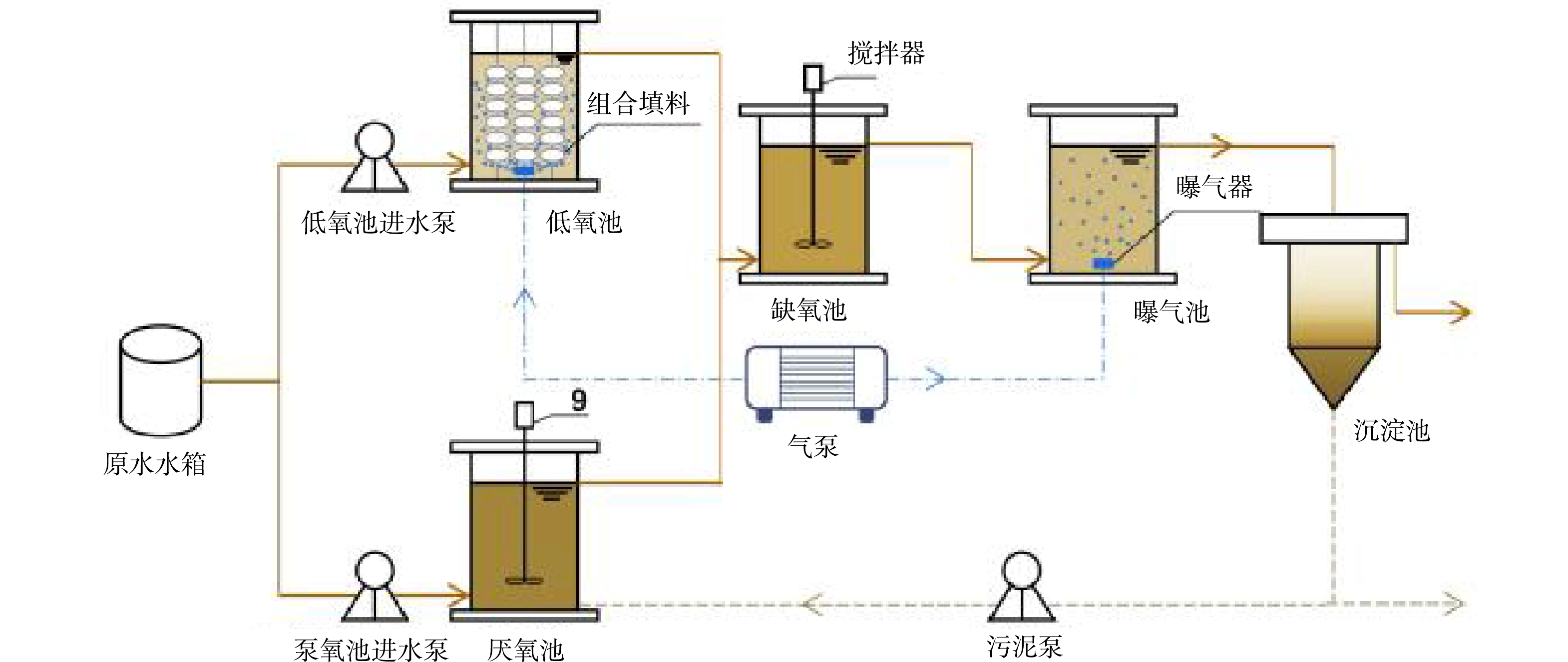
 下载:
下载:
